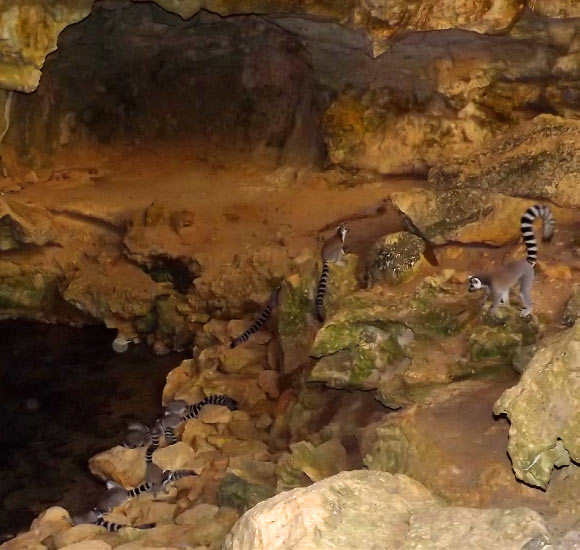A new study published in the journal Madagascar Conservation and Development has shown the ring-tailed lemurs (Lemur catta) are the world’s only primates that sleep in the same caves on a nightly basis.

Ring-tailed lemurs, Lemur catta, in Tsimanampesotse National Park, Madagascar. Image credit: Violaine Pellicheroo / Michelle Sauther.
Ring-tailed lemurs are found only in Madagascar. They are easily identified by their characteristic, black and white ringed tails, which can be twice as long as their bodies.
These animals weigh roughly 2 kg with a head-body length of up to 45 cm and are highly social, congregating in groups of up to 30 individuals. Sporting fox-like snouts and slender frames, they are unusual among lemurs, spending a considerable amount of time on the ground feeding on leaves and fruit and socializing.
Study lead author Dr Michelle Sauther from the University of Colorado Boulder with co-authors observed the ring-tailed lemurs in Tsimanampesotse National Park and the Tsinjoriake Protected Area in southwestern Madagascar between 2006 and 2013. The scientists used field observations and motion-detector camera traps to chart the behavior and movements of 11 different troops of ring-tailed lemurs.
“The ring-tailed lemurs may be opting to sleep in caves for several reasons. While the cave-sleeping behavior is likely important because it provides safety from potential predators, it also can provide the primates with access to water and nutrients, help to regulate their body temperatures during cold or hot weather and provide refuge from encroaching human activities like deforestation,” Dr Sauther said.
“The remarkable thing about our study was that over a 6-year period, the same troops of ring-tailed lemurs used the same sleeping caves on a regular, daily basis. What we are seeing is a consistent, habitual use of caves as sleeping sites by these primates, a wonderful behavioral adaptation we had not known about before.”
“Although sleeping in caves by ring-tailed lemurs has likely been going on for millennia, it is only now being recognized as a regular behavior.”
One of the early clues to the cave sleeping by the lemurs was their presence on limestone cliffs adjacent to spiny forest trees or on the ground when the team arrived at the study sites early in the morning.
“They seemed to come out of nowhere, and it was not from the trees. We were baffled. But when we began arriving at the study sites earlier and earlier in the mornings, we observed them climbing out of the limestone caves.”
The primary predator of the lemurs is a cat-like, carnivorous mammal called a fossa (Cryptoprocta ferox) native only to Madagascar that is closely related to the mongoose and may weigh up to 9 kg. Fossil evidence shows a cougar-sized relative of the fossa that only became extinct several thousand years ago likely preyed on lemurs as well.
“There is evidence that some early ancestors of humans in South Africa may have used caves to protect themselves from predators,” Dr Sauther said.
The remains of hominids going back several million years have been found inside or near limestone caves there, and some fossil bones have evidence of damage consistent with the bite of saber-toothed cats.
“We think cave-sleeping is something ring-tailed lemurs have been doing for a long time. The behavior may be characteristic of a deep primate heritage that goes back millions of years,” Dr Sauther concluded.
______
Sauther ML et al. 2013. Limestone cliff – face and cave use by wild ring-tailed lemurs (Lemur catta) in southwestern Madagascar. Madagascar Conservation and Development, vol. 8, no. 2; doi: 10.4314/mcd.v8i2.5







